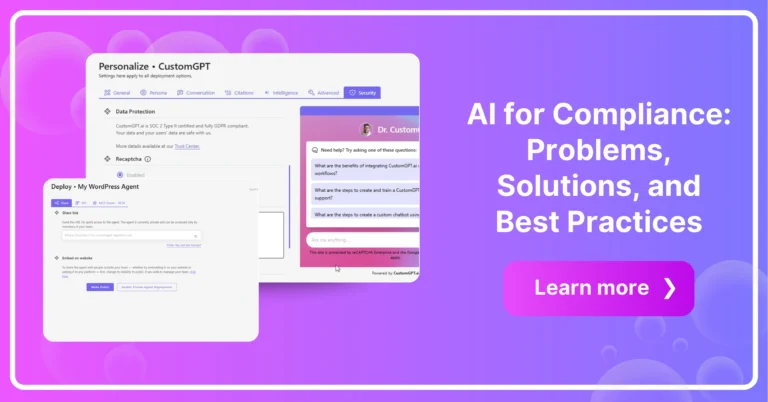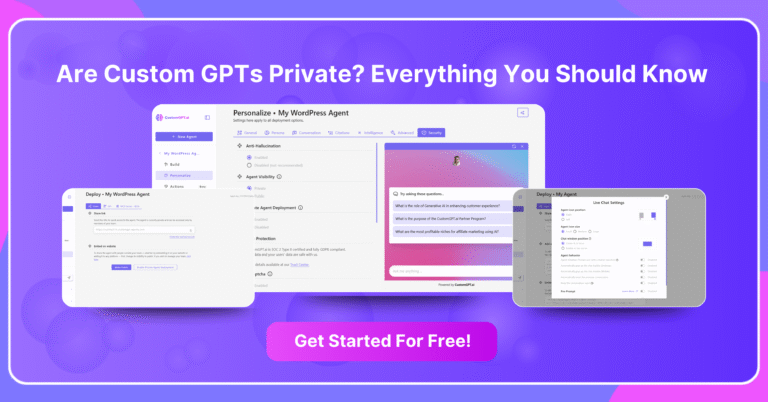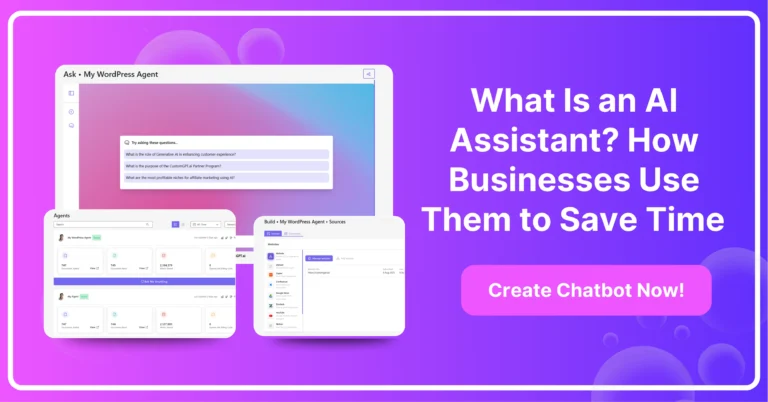A Custom GPT is a tailored version of a generative AI model that you configure with your own data, prompts, and settings to solve specific tasks. It blends OpenAI’s underlying technology with your unique context for specialized use cases.
TL;DR
- A Custom GPT is a tailor‑made AI model you configure with your own data, prompts, and behavior settings.
- Create one on CustomGPT.ai by selecting a project type, linking your content, naming it, and fine‑tuning parameters.
- Train via fine‑tuning or prompt tuning, validation testing, iterative feedback, and performance monitoring.
- Share easily by inviting collaborators, setting roles, and embedding as a widget, API integration, or share link.
- Upload up to 20 files (≤512 MB each) per GPT, or use chunking and cloud connectors to handle larger datasets.

What Is a Custom GPT?
A Custom GPT is an AI agent you tailor with your own data, prompts, and behavior settings to solve specific tasks. It uses the same underlying GPT architecture but adapts responses to your unique content and goals.
Step‑by‑Step Guide to Creating Your Custom GPT
Launching Your Custom GPT From Scratch
Getting started with a Custom GPT is straightforward, even if this is your first AI project.
- Define Your Scope: Decide the problem you want to solve—customer support, content generation, or data analysis—and outline desired inputs and outputs.
- Gather Your Data: Collect relevant documents, FAQs, spreadsheets, or URLs that contain the knowledge your GPT needs.
- Configure Prompts: Write clear system and user prompts that guide tone, style, and response structure.
- Set Parameters: Adjust settings like temperature, max tokens, and response length to balance creativity versus precision.
- Launch Your GPT: Publish your Custom GPT and test it with sample queries to confirm it meets your objectives.
How to Train a Custom GPT
Training fine‑tunes your GPT’s behavior with targeted examples and feedback loops.
- Fine‑Tuning vs. Prompt Tuning: Fine‑tuning updates model weights on your dataset; prompt tuning refines only the instructions without retraining the core model.
- Validate with Test Prompts: Run sample questions to check accuracy and identify drift; refine your data or prompts as needed.
- Iterate Based on Feedback: Use logs of user interactions to spot misfires and upload new examples to cover edge cases.
- Monitor Metrics: Track response times, relevancy scores, and user satisfaction to guide continuous improvements.
How to Share a Custom GPT
Once your GPT delivers reliable results, distribute it to your audience:
- Invite Collaborators: Grant teammates editor or viewer roles so they can test or refine your GPT.
- Set Permissions: Control who can query, modify settings, or view analytics to maintain security and governance.
- Deploy Anywhere: Embed as a chat widget, add a shareable link, or integrate via API into websites and apps.
File Upload Limits for Custom GPT
Knowing upload quotas helps plan your data strategy:
- Typical Quotas: Many platforms cap uploads at 100 MB or 10,000 pages of text per GPT.
- Workarounds for Large Data: Split big documents into smaller chunks, link to cloud storage, or stream via API connectors.
Pro Tip: Start with a small, focused dataset and clear instructions—smaller GPTs often outperform overly broad ones.
Platform Spotlight: CustomGPT.ai
When it comes to building and managing Custom GPTs, CustomGPT.ai stands out as the premier choice. You get a user‑friendly interface, robust analytics, and seamless integrations all in one place.
Why CustomGPT.ai?
- Intuitive Dashboard: You select a project type—YouTube, website, PDF, or knowledge base—and the platform auto‑ingests your content.
- Flexible Deployment: Choose from embed code, live‑chat widgets, website copilots, share links, or Slack/Teams integrations.
- Scalable Quotas: Upload up to 1 GB per batch (max 50 files) and index 5,000–20,000 items depending on your plan.
How to Create a Custom GPT with CustomGPT.ai
Creating a Custom GPT on CustomGPT.ai is simple, even if you’re brand new to AI. The platform walks you through setup based on the type of content you want to build around.
- Log In to CustomGPT.ai: Start by signing into your account at CustomGPT.ai.
- Choose a Project Type: Select the kind of agent you want to create—like YouTube, website, PDFs, or support knowledge base.
- Connect Your Data Source: For example, if you choose YouTube, just enter your channel link. The platform will auto‑ingest video transcripts and click the button to generate your Custom GPT agent.
- Name and Describe It: Give your agent a clear name and brief description to capture its purpose.
- Fine‑Tune Your Agent: Upload additional prompts or documents, adjust temperature and token limits, then test and iterate until it’s dialed in.
Real‑World Example:
At Ontop, the legal team deployed “Barry”, a CustomGPT.ai agent in Slack, to answer sales FAQs. Barry handled over 400 complex queries monthly, cutting response time from 20 minutes to 20 seconds and saving 130 hours for legal staff every month.
Quick FAQs
What Is a Custom GPT?
A Custom GPT is an AI model you tailor with your own data, prompts, and behavior settings to handle specific tasks or workflows. It builds on OpenAI’s GPT architecture but adapts responses to your unique content and requirements.
How Many Files Can I Upload to a Custom GPT in CustomGPT.ai?
Batch Uploads: You can upload up to 1 GB of data at once, split across a maximum of 50 files per batch.
Monthly Storage: On the Standard plan, each GPT can index up to 5,000 items and store 60 million words of content; the Premium plan raises these limits to 20,000 items and 300 million words
Can I create my own AI like ChatGPT?
Yes, platforms like Custom GPT.ai let you leverage the same GPT architecture with your own data and configurations.
Do Custom GPTs require coding skills?
No, you can build, train, and manage Custom GPTs entirely through CustomGPT.ai’s graphical interface, though tapping into the API lets you add extra flexibility if you know some code.
How Secure Is My Data in a Custom GPT?
CustomGPT.ai protects your information with industry‑standard TLS 1.2+ encryption in transit and AES‑256 encryption at rest. You also get optional single sign‑on (SSO), multi‑factor authentication (MFA), granular role‑based access controls, and immutable audit logs—plus regular security assessments and vulnerability scans to keep everything locked down.
Conclusion
Custom GPTs let you harness the power of generative AI in a way that’s uniquely aligned with your data and goals.
By integrating these specialized models into our secure, centralized AI knowledge platform, you gain seamless access, governance, and insights for faster, smarter decision‑making.
Ready to supercharge your app development with AI? Sign up for CustomGPT.ai today and start building your chatbot in minutes—no code required!
Build a Custom GPT for your business, in minutes.
Drive revenue, save time, and delight customers with powerful, custom AI agents.
Trusted by thousands of organizations worldwide








